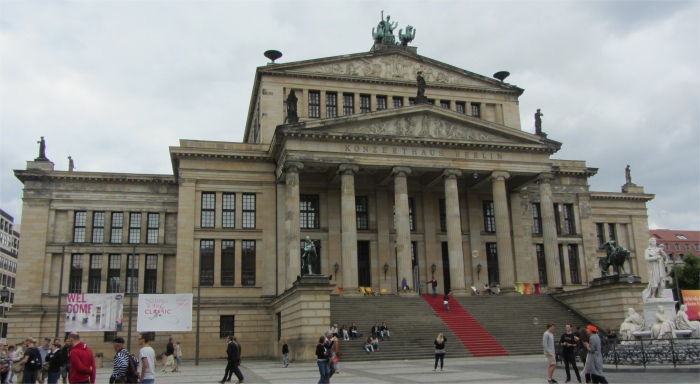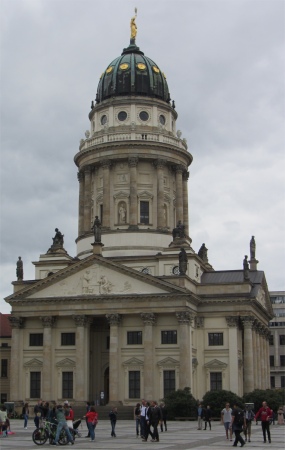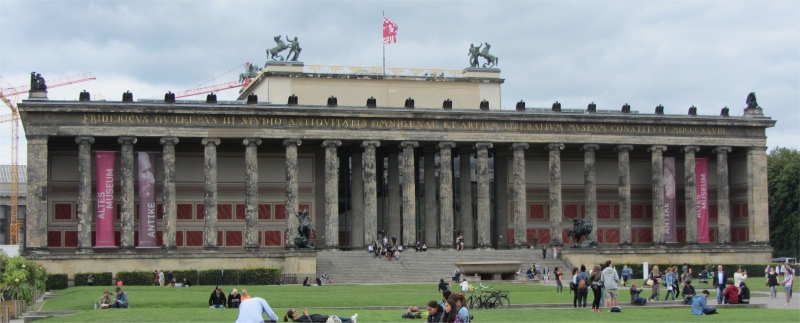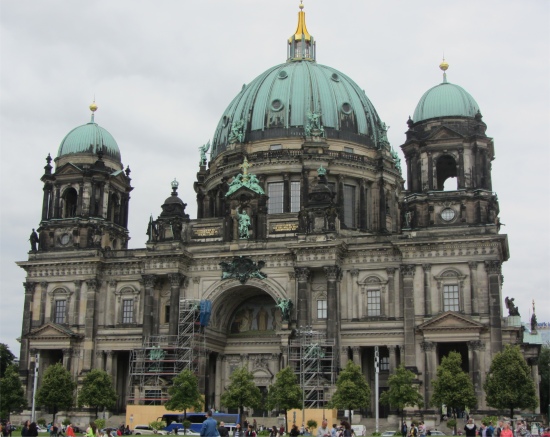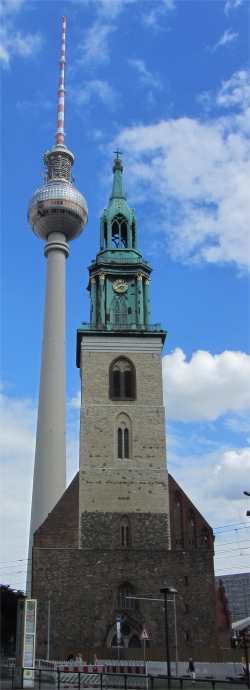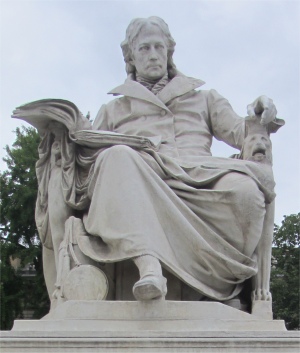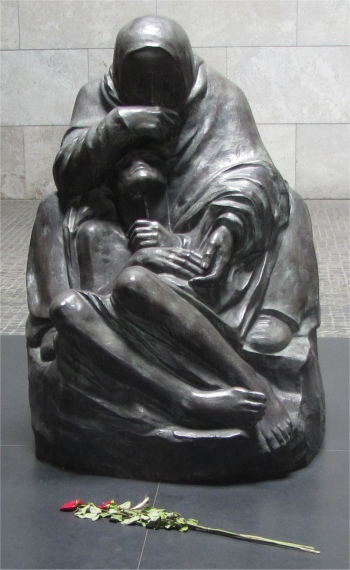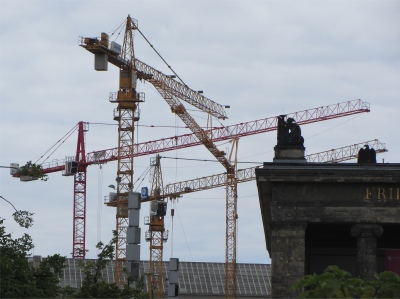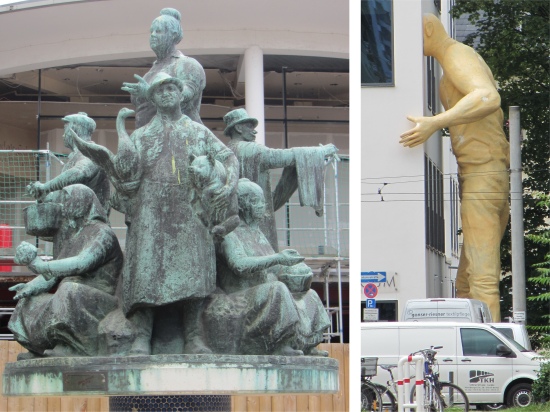Giving up the attempt as a bad job for today, we marched through the Brandenburg Gate into the Pariser Platz and turned off down the Wilhelmstrasse. As we ambled down this broad street, I became aware of a subtle difference introduced since I was last in Berlin eight years ago. All down this street, and indeed all over the city, literally thousands of display boards, around 1.7m tall, containing pictures and text in German and English, describing the history behind the building or feature they were stood in front of. They were even more open about their war track record than they were eight years ago.
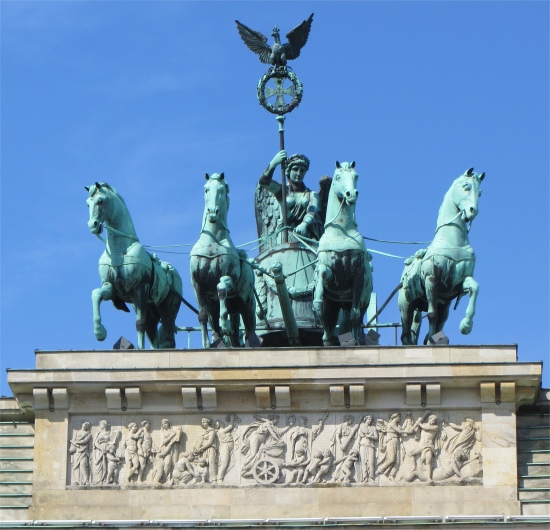 Quadriga on Brandenburg Gate |
Many of the distinguished monuments and buildings of the city (chiefly by Andreas Schlüter and Karl Friedrich Schinkel) date from the 18th and early 19th centuries. Berlin was the centre of the Revolution of 1848 against King Frederick William IV. The construction of railroads (1840-61) gave it additional importance as an industrial and commercial centre. Berlin also became part of a canal system that linked it to the Oder, Elbe, and Rhine rivers and to the North Sea. In 1866 it became the seat of the North German Confederation and in 1871 it was made the capital of the German Empire. The city prospered and expanded rapidly, becoming one of the great urban centres of the world. Berlin's population had increased from 201,000 in 1819 to 914,000 in 1871; by 1900 it was 2,712,000.
The German military defeat of 1918 brought on a period of social and political unrest. After the establishment of a Socialist government in November 1918, Berlin was the scene of the abortive uprising of the Communist Spartacus party in January 1919, and of the conservative putsch of 1920. As the capital of the Weimar Republic, Berlin suffered severe economic crises in the 1920s, but it was also a brilliant cultural centre. Throughout the Nazi regime (1933-45) Berlin remained the second largest city of Europe, a notable economic, political, and educational centre, and a huge inland port with a flourishing world trade. It was also the major communications and transportation hub of Central Europe. During World War II, Berlin was repeatedly bombed from the air by the Allies, but the heaviest destruction was caused by a Soviet artillery barrage of unprecedented intensity that preceded the capture of the city by Marshal Zhukov on May 2nd 1945.
When we reached Niederkirchnerstrasse, we noticed a stretch of the Berlin Wall still standing. The Berlin Wall, which separated the city in an eastern and western part, was the defining symbol of the Cold War. Built by the government of the DDR to prevent East Germans from escaping to the West, most of the Berlin Wall has been demolished since the border between East and West Berlin opened in 1989.
After the Second World War, defeated Germany was divided up into four parts: an American, British, French and Soviet occupation zone. Berlin itself, which was situated in the Soviet zone, was divided into four sectors. In 1948, the Soviet authorities tried to annex the whole city and started a blockade of the US, British and French sectors. The plans failed due to the Berlin Airlift which carried supplies to the western sectors, and in May 1949 the blockade was lifted. That same year, the Soviet part of Germany became the German Democratic Republic (GDR) with East Berlin as its capital. The other zones became the Federal Republic of Germany with the capital Bonn. The western part of Berlin became a separate enclave surrounded by East Germany.
Until 1961, East Germans could move freely between the western and eastern parts of Berlin. But many East Berliners were attracted by the more prosperous West, and by 1961 up to 20,000 East Germans a month flocked to West Berlin. On August 12th 1961 the East German authorities decided to close the border around the Western sectors of Berlin in order to prevent people from fleeing. Officially, it was an antifascist protection barrier to defend the East against Western aggression. The next day, early morning August 13th, West Berlin was surrounded by barbed wire. Traffic at the border was halted and the underground and S-bahn connecting the different sides of the city were put out of operation. Houses at the eastern side of the border were evacuated and the windows on the border side were bricked up.
Over time, the barbed wire was replaced by a 3.6 meter high wall. Along the Wall's east side ran a "death strip", an area controlled by guards. A total of 302 watchtowers and 20 bunkers were built along the 155 kilometre long border. The guards were given the order to shoot at escapees. As a result, during the 28 years of the Wall's existence, 192 people were killed in their attempt to cross the border to the West. One of the first and most well-known was Peter Fechter, an 18-year old who was shot by a guard while he was climbing over the wall. He fell down and despite his cries for help the East German guards ignored him and an hour later he had bled to death. A memorial in the Zimmerstraße now remembers the spot where he died.
In May 1989, shortly after Soviet President Gorbatchev had abolished the Brezhnev Doctrine, Hungary opened its border with Austria. This allowed East Germans to flock to the West via Hungary. Meanwhile, street protests drawing more and more people put pressure on the GDR government. Finally on November 9th 1989, travel restrictions were lifted. Mere hours later throngs of people gathered at the border gates demanding access. The confused guards, who had not received any new instructions, bowed under the pressure. They opened the gates and people flooded into West Berlin. The Wall had fallen.
Most of the Wall has been dismantled since, but some sections still stand. Demolished sections have been replaced by a double row of cobblestones. The most famous section of the wall that is still standing is the 1316 meter long East Side Gallery. In 1990 artists were invited to paint this part of the wall, which turned it into one large open-air gallery. It is located along Mühlenstraße between Warschauer Straße and the Ostbahnhof and contains 106 paintings.
 Trabi World - Meryl Pulling Her Hair Out on Learning Rex has Put in a Bid for One |
For the uninitiated, a Trabant is a car that was produced in East Germany during cold war times. At a time when people in the UK thought that the Mini was the "in thing", the East Germans and other Eastern Block countries had the Trabant to pose around in, or not as the case was. Like the mini, the Trabant had a long production run, which ceased in the 1990s.
The Trabant had a massive two cylinder, 600cc two-stroke engine under the bonnet, and the spacious engine compartment was large enough to fit a fuel tank above the power unit. This is all well and good apart from the fact that you have to open the bonnet to put fuel into it. After a run to the petrol station you can guarantee that the engine will be hot, so therefore "ENGINE + FUEL VAPOUR = BANG". Who needs the rush of a sports car when you can watch your life flash before your eyes every time you fill up?
The majority of the body panels are made from a plastic type substance formed in moulds. As you can imagine the protection offered by such panels is quite minimal, okay let's face it, non-existent. Apparently, during the cold war, Eastern Block citizens who owned Trabants had one aim in life, to get a Lada! At least now they can aspire to other things.
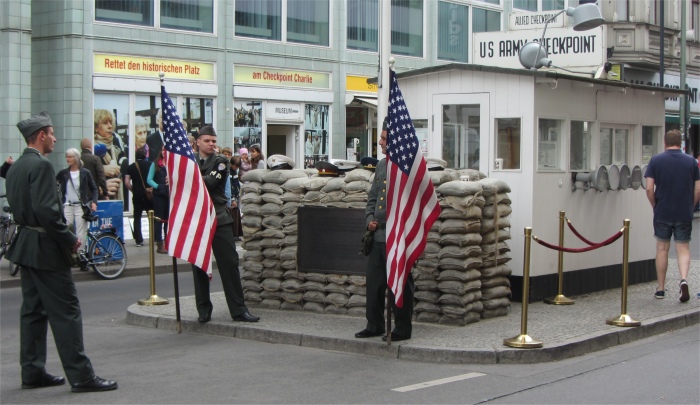 Checkpoint Charlie |
The Berlin Wall was erected in 1961 by the East German government to prevent its citizens from fleeing to the more prosperous West. Shortly after the wall was built, President John F. Kennedy ordered the U.S. forces to build three checkpoints at different points in the wall through which diplomatic corps and allied forces could enter West Berlin. Checkpoint Charlie became the most famous. It got its name from the phonetic alphabet. (The others were Alpha and Bravo... a, b, c). By 1962, this checkpoint was the only place at which foreigners visiting Berlin could cross from West to East and back again. Located in the Friedrichstadt neighbourhood in the heart of Berlin, the checkpoint was the subject of many movies and appeared frequently in spy novels penned during the Cold War era.
In the early years, Checkpoint Charlie was the site of a few stand-offs between East and West, America and the Soviets, most notoriously in 1961 when American and Soviet tanks faced each other at the checkpoint. Both Kennedy and his Soviet nemesis Nikita Khrushchev visited the checkpoint shortly after it was erected. Checkpoint Charlie was removed in June of 1990, when German reunification was almost complete. Removal was not difficult as the Americans never built any permanent structures at the site.
Today, a line of bricks traces the path where the Berlin Wall once stood and now a replica of the Checkpoint Charlie booth and sign stands at the original site. The original booth is in the Allied Museum in Zehlendorf. The watchtower, also part of the original checkpoint, was removed in 2000 to make way for stores and offices though, currently, no commercial buildings occupy the space.
Opposite the checkpoint on a small piece of wasteland, an excellent little open-air exhibition was located that recounted the history of the Berlin Wall, escape attempts and other aspects about the Wall.
We walked up Friedrichstrass a while and then meandered through back streets to the harmonious Gendarmenmarkt, known as one of the most beautiful squares in Europe. It was created at the end of the 17th century as a market place, the Linden Markt. The current name is derived from the Gens d'Armes, an elite Prussian mounted regiment that was quartered here from 1736 to 1773. In 1777, the square was redeveloped after plans by Georg Christian Unger. Gendarmenmarkt is now a quiet place with three landmark buildings: the Französischer Dom (French cathedral), Deutscher Dom (German cathedral) and the Konzerthaus (concert hall). In the middle of the square is a statue of Friedrich Schiller, a famous German poet.


